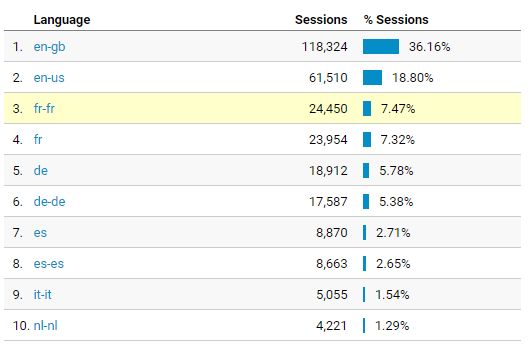How to take manufacturing international and export online
On 24 August it was announced that the UK economy grew by 0.3 per cent in the third quarter of 2017 — equating to an annual growth of 1.7 per cent.
This is despite the weak pound (down 13 per cent from pre-referendum level against the dollar at the time of writing), which means that British-made goods are more competitive in the EU and further afield.
While imports are more expensive to British companies and also consumers, it means that the last quarter of 2017 will be the best time to export in decades.
Currently Britain exports €104 billion of goods to the rest of the world, and a further €94 billion to the EU.
While growth in US manufacturing has been found to slow, final readings from August show that Britain’s manufacturing sector rose to a four month high as the purchasing manager’s index came to 56.9 from 55.1 the previous month.
In those months companies across the country have seen renewed interest from EU countries, the US, China, and Australia.

So why should a manufacturer take a website international?
There are many reasons, but the main one is to attract a greater variety of traffic to your website.
If you imagine a commercial website as a giant net and different countries as pools as traffic, each net can only be cast around one ‘pool’ or country, this is basically how Google treats websites — as nets.
As stated in the introduction, now is a better time for a manufacturer to cast its net wider than ever before, especially with user behaviour evolving with more and more people shopping outside of the typical brick and mortar store.
Step 1 – Identify a country you want to target
Depending on how well you know your business, and the limitations of shipping/what your product is, one good way to gauge potential interest from other countries would be to look in your Google Analytics account.
Here you can see a breakdown of top visitors to your website via country. For example, as an English manufacturer with a single website targeting the United Kingdom – you’d expect to see most of the users visiting from the United Kingdom.
The countries after this get interesting, for example, you may see that the next most popular country is France, Spain, or the US and so on, so this is a good indicator of which country to expand to.

Step 2 – Identify what your website is built with
Some frameworks/CMS’s are easier to go international with than others, we strongly feel that WordPress is the best for this job, with plugins such as WPML that we have used and tested extensively, it alleviates a lot of headaches and hard work such as creating international versions of pages in a single click.
This plugin automatically adds HREFLANG attributes to the pages that you create, and ties them all together in a single database structure, making the website much more flexible than other solutions.
Hreflang tags essentially tell search engines which version of a page it is and what all the other language alternatives are.
However, if your site is not WordPress then don’t worry, it’s possible to go international with almost any framework, there will probably just be a bit more technical/development leg work involved.

Step 3 – Country code targeting
There are three ways of how you can structurally lay the foundations for your international sites, and we have a good blog post written about this subject, but I’ll touch on them all again now.
International Subdomains
Firstly there is the subdomain option such as www.gb.yourwebsite.com or www.us.yourwebsite.com. This helps to avoid any extra click depth for users and search engines, but it’s crucial that this method is configured correctly and may be the most technically difficult to implement.
International Subfolders
Next you can go for a sub folder structure such as www.yourwebsite.com/en-gb/ or www.yourwebsite.com/en-us/ which is much easier to accomplish, this way you’re able to include the ISO language and country codes in the URL itself. Using the subfolder structure also ensures you’re keeping all of your domain’s power in one place rather than spreading it across multiple domains/subdomains.
International ccTLDs
One of the best methods, but also the most resource intensive, is a different ccTLD (country code top level domain) for each country specific website, for example www.yourwebsite.com (for US), www.yourwebsite.co.uk (for United Kingdom), www.yourwebsite.es (for Spain). ccTLDs arguably give search engines an extra signal as to which country they’re targeting and it reduces the click depth the most out of all options.
All of these methods work but they’re just one part of the overall strategy,
Step 4 – More technical considerations
There are a multitude of tips, tricks and necessities that need to be done to fully transform your website to target another country and language. Hreflang is one of the most important, but you cannot forget about other things such as specifying the page language in the document and the HTTP server header language.
This is done through ISO codes, first you specify the language (‘en’ for English, ‘ca’ for Catalan, ‘da’ for Danish etc.) and then you specify the country (‘hk’ for Hong Kong, ‘in’ for India, ‘it’ for Italy etc.). This is important because some countries have more than one popular language.
They can be combined together so for an English speaking Great Britain you’d have ‘en-GB’ and for English speaking United States you’d have ‘en-US’ and many other combinations depending on the language and country.
Furthermore, you need to ensure that you’re optimising for search engines other than just Google, so make sure to include a language meta tag especially just for Bing.
If you don’t have an office in the country you’re aiming to expand to then it’s well worth getting in touch with your phone provider and asking for a country specific number to where you want your website to expand to and have it redirect to your usual office phone.

Step 5 – Content considerations
It’s very important to conduct keyword research for the country you’re targeting, especially if it’s going to be from one language to a completely different language. Even if you’re going from the UK to the US you still need to be mindful of slight differences in spelling and word uses. For example in the US you’d change the S’s to Z’s, custom to bespoke, aluminium to aluminum etc. All these little differences will impact how well your international site performs.
Again, if you don’t have an office in the country you’re targeting you should remove your company’s address for this country – not to deceive users, you could still write that you are based in the country that you are – but if you’ve got an English address listed on an American website it’s not going to help your position in search engines.
Step 6 – Monitoring the success
You will need to set up different Google Search Consoles and different views/Google Analytic accounts for each language variant of the website so you can accurately separate and track the different streams of traffic.
If you’re using keyword monitoring software you’ll also need to setup another project to track the keywords from your keywords research for that country, as it won’t be an accurate or fair portrayal if you’re using English keywords to track the success of a website written in Spanish… obviously.
Conclusion
These are just a few of the factors needed to be considered when taking your business internationally online, and you need to ensure they’re all doing in the right order and correctly or you’ll have wasted a lot of time and could potentially damage your existing website.
However, if done correctly then the benefits can be enormous. As mentioned earlier at the start of this guide the analogy of casting a net (website) around different pools (countries), once you’re internationally set up you can cast more nets, meaning being much more organically competitive in different country search landscapes.
The more countries you target via technically perfect international strategies, the better you’ll perform in the search engines for these countries as they’ll be picking up on all the signals mentioned in the above steps.
SALT.agency has helped manufacturers go international in as little as 12 weeks.
For more information on how we can help you reach your global potential, contact us today.
